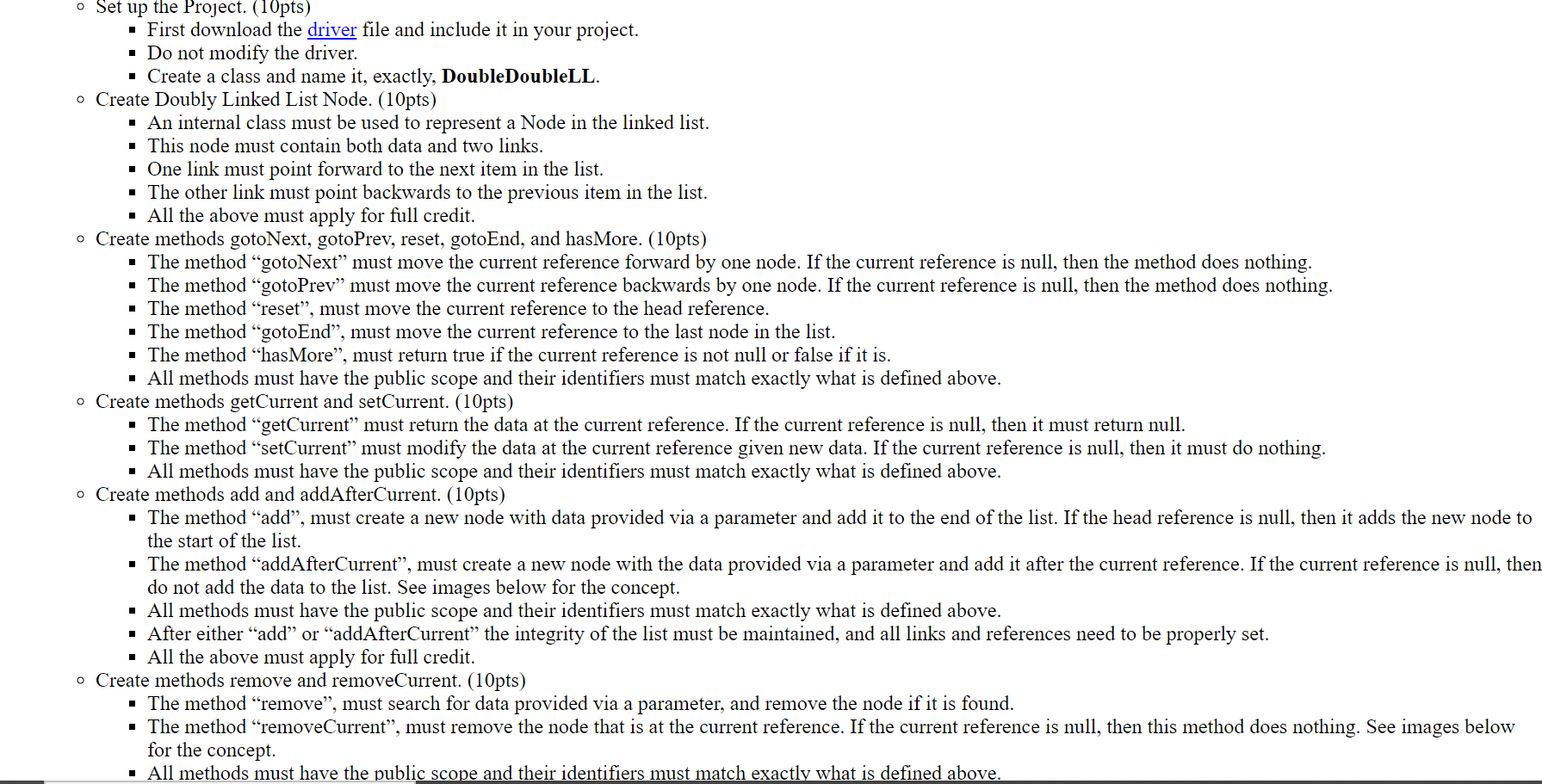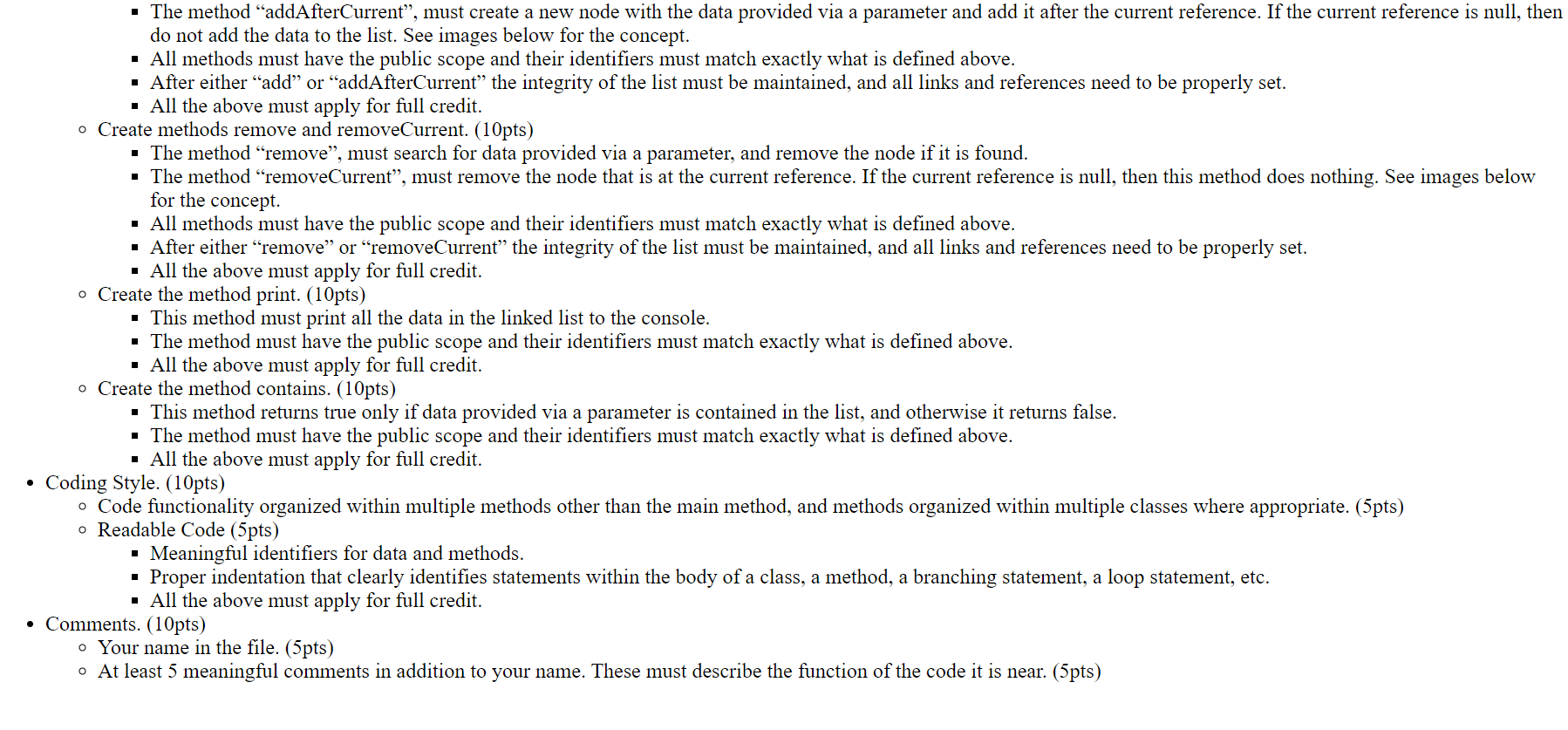Written in java



Write a doubly linked list of type double. This link list is similar to the singly linked list except that each node in addition to having data and a next link it now has a previous link. Lab Solution Requirements: - Functionality. (80pts) - No Syntax, Major Run-Time, or Major Logic Errors. (80pts*) - *Code that cannot be compiled due to syntax errors is nonfunctional code and will receive no points for this entire section. - *Code that cannot be executed or tested due to major run-time or logic errors is nonfunctional code and will receive no points for this entire section. - Set up the Project. (10pts) - Set up the Project. (10pts) - First download the driver file and include it in your project. - Do not modify the driver. - Create a class and name it, exactly, DoubleDoubleLL. - Create Doubly Linked List Node. (10pts) - An internal class must be used to represent a Node in the linked list. - This node must contain both data and two links. - One link must point forward to the next item in the list. - The other link must point backwards to the previous item in the list. - All the above must apply for full credit. - Create methods gotoNext, gotoPrev, reset, gotoEnd, and hasMore. (10pts) - The method "gotoNext" must move the current reference forward by one node. If the current reference is null, then the method does nothing. - The method "gotoPrev" must move the current reference backwards by one node. If the current reference is null, then the method does nothing. - The method "reset", must move the current reference to the head reference. - The method "gotoEnd", must move the current reference to the last node in the list. - The method "hasMore", must return true if the current reference is not null or false if it is. - All methods must have the public scope and their identifiers must match exactly what is defined above. - Create methods getCurrent and setCurrent. (10pts) - The method "getCurrent" must return the data at the current reference. If the current reference is null, then it must return null. - The method "setCurrent" must modify the data at the current reference given new data. If the current reference is null, then it must do nothing. - All methods must have the public scope and their identifiers must match exactly what is defined above. - Create methods add and addAfterCurrent. (10pts) - The method "add", must create a new node with data provided via a parameter and add it to the end of the list. If the head reference is null, then it adds the new node to the start of the list. - The method "addAfterCurrent", must create a new node with the data provided via a parameter and add it after the current reference. If the current reference is null, the do not add the data to the list. See images below for the concept. - All methods must have the public scope and their identifiers must match exactly what is defined above. - After either "add" or "addAfterCurrent" the integrity of the list must be maintained, and all links and references need to be properly set. - All the above must apply for full credit. - Create methods remove and removeCurrent. (10pts) - The method "remove", must search for data provided via a parameter, and remove the node if it is found. - The method "removeCurrent", must remove the node that is at the current reference. If the current reference is null, then this method does nothing. See images below for the concept. - All methods must have the public scope and their identifiers must match exactly what is defined above. - The method "addAfterCurrent", must create a new node with the data provided via a parameter and add it after the current reference. If the current reference is null, then do not add the data to the list. See images below for the concept. - All methods must have the public scope and their identifiers must match exactly what is defined above. - After either "add" or "addAfterCurrent" the integrity of the list must be maintained, and all links and references need to be properly set. - All the above must apply for full credit. - Create methods remove and removeCurrent. (10pts) - The method "remove", must search for data provided via a parameter, and remove the node if it is found. - The method "removeCurrent", must remove the node that is at the current reference. If the current reference is null, then this method does nothing. See images below for the concept. - All methods must have the public scope and their identifiers must match exactly what is defined above. - After either "remove" or "removeCurrent" the integrity of the list must be maintained, and all links and references need to be properly set. - All the above must apply for full credit. - Create the method print. (10pts) - This method must print all the data in the linked list to the console. - The method must have the public scope and their identifiers must match exactly what is defined above. - All the above must apply for full credit. - Create the method contains. (10pts) - This method returns true only if data provided via a parameter is contained in the list, and otherwise it returns false. - The method must have the public scope and their identifiers must match exactly what is defined above. - All the above must apply for full credit. - Coding Style. (10pts) - Code functionality organized within multiple methods other than the main method, and methods organized within multiple classes where appropriate. (5pts) - Readable Code (5pts) - Meaningful identifiers for data and methods. - Proper indentation that clearly identifies statements within the body of a class, a method, a branching statement, a loop statement, etc. - All the above must apply for full credit. - Comments. (10pts) - Your name in the file. (5pts) - At least 5 meaningful comments in addition to your name. These must describe the function of the code it is near. (5pts)









